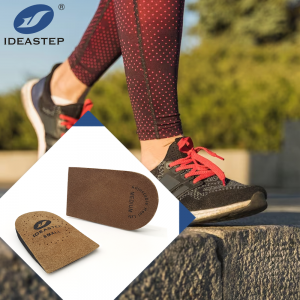
Heel lifts, also known as shoe inserts or shoe wedges. In our previous blog”What Are Heel Lifts Used For?“, we introduced some of its uses. They are commonly used to address various foot and lower limb conditions, including leg length discrepancies, Achilles tendon issues, and foot alignment problems. In this article, we will delve into the potential benefits and considerations regarding the use of heel lifts for aligning the heel and their effectiveness in addressing related issues.
1. Leg Length Discrepancies
Heel lifts are often utilized to address leg length inequalities, where one leg is shorter than the other. By placing a lift inside the shoe of the shorter leg, the discrepancy can be compensated for, potentially reducing gait abnormalities and associated discomfort. However, it’s important to note that the use of heel lifts for leg length inequalities should be based on a professional assessment and prescription to ensure proper alignment and function.
2. Achilles Tendon Issues
Individuals with Achilles tendon problems, such as tendonitis or tightness, may benefit from heel lifts to reduce tension on the tendon. By slightly elevating the heel, heel lifts can potentially alleviate strain on the Achilles tendon and promote a more comfortable foot position. This can aid in the management of Achilles tendon issues and contribute to improved foot alignment during movement.
3. Foot Alignment
Heel lifts are sometimes recommended to address foot alignment issues, such as overpronation or supination. Overpronation occurs when the foot rolls inward excessively, while supination involves an outward rolling of the foot. Heel lifts can be used to help correct these alignment issues by providing support and promoting a more neutral position for the foot and ankle.
4. Considerations for Effectiveness
The effectiveness of heel lifts in aligning the heel and addressing related issues depends on various factors, including the specific condition being addressed, the individual’s biomechanics, and the proper fitting and placement of the heel lift. Additionally, the underlying cause of the alignment issue should be thoroughly evaluated to determine whether heel lifts are an appropriate intervention.
5. Professional Assessment and Prescription
It is crucial for individuals considering the use of heel lifts for foot alignment to seek professional assessment and guidance from a qualified healthcare provider, such as a podiatrist or orthopedic specialist. A thorough evaluation can help determine the appropriateness of heel lifts, ensure proper fitting, and address any underlying issues contributing to foot misalignment.
6. Potential Limitations
While heel lifts can be beneficial in certain cases, it’s important to recognize that they may not be suitable for all individuals or foot conditions. Some individuals may experience discomfort or altered gait patterns with the use of heel lifts, and in some cases, alternative interventions such as physical therapy or orthotic devices may be more appropriate.
In conclusion, heel lifts have the potential to assist in aligning the heel and addressing various foot and lower limb issues, including leg length discrepancies, Achilles tendon problems, and foot alignment issues. However, the effectiveness of heel lifts is contingent upon proper assessment, fitting, and consideration of individual factors. Expand more related content: https://www.aideastep.com/heel-pads/.
